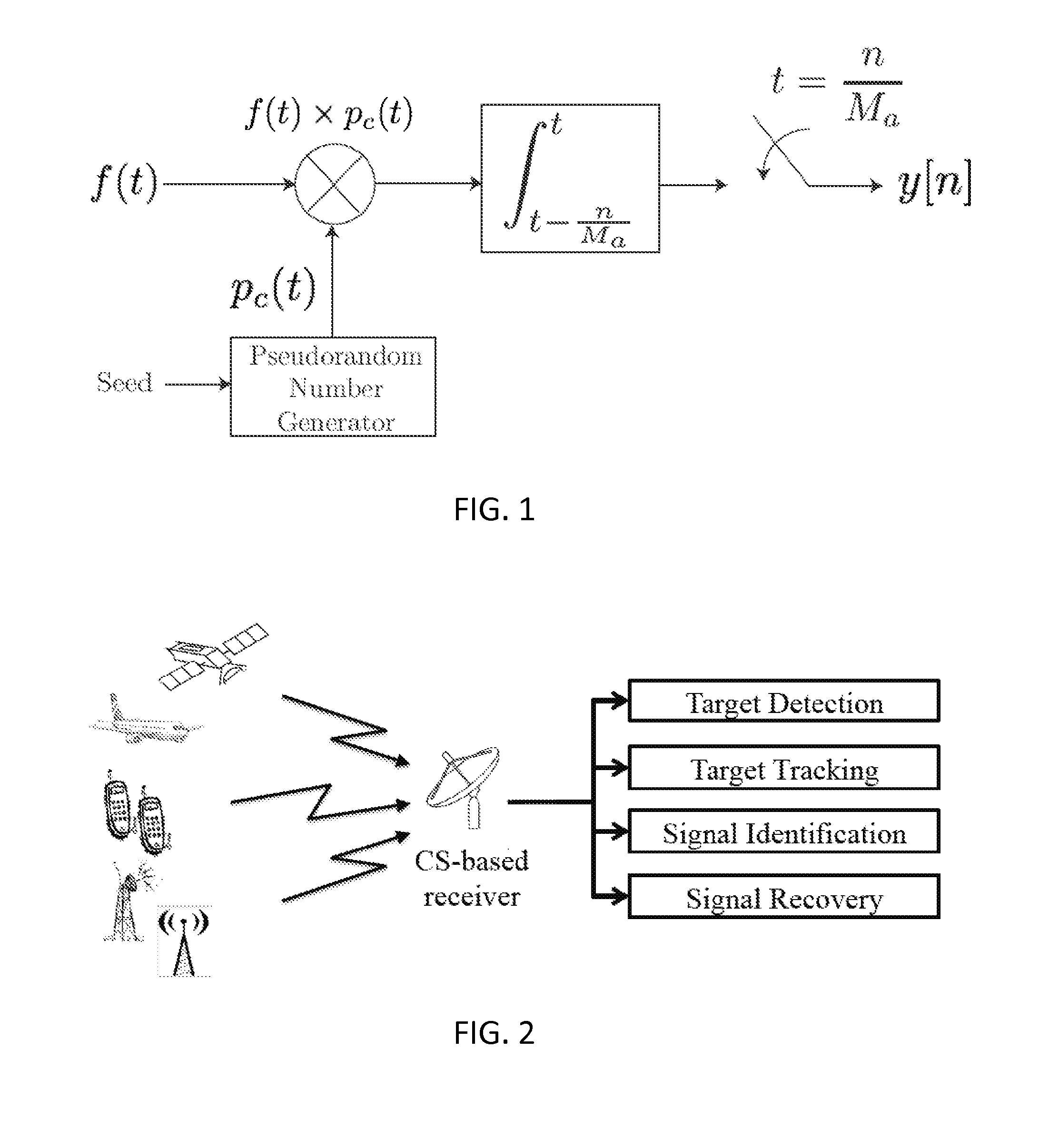[0038]An N-dimensional signal can be efficiently captured and recovered using MN randomized linear measurements provided that the signal can be sparsely expressed in a known basis or frame (see E. J. Candès, “Compressive sampling,” in Proc. International Congress of Mathematicians, vol. 3, pp. 1433-1452, Madrid, Spain, 2006 and D. L. Donoho, “
Compressed sensing,”IEEE Trans. Info. Theory, vol. 52, no. 4, pp. 1289-1306, September 2006). This has motivated a number of practical hardware designs that enable efficient acquisition of sparse signals at the expense of a slight increase in the computation required to recover the signal (see M. F. Duarte, M. A. Davenport, D. Takhar, J. N. Laska, T. Sun, K. E Kelly, and R. G. Baraniuk, “
Single pixel imaging via compressive sampling,”IEEE
Signal Proc. Mag., vol. 25, no. 2, pp. 83-91, Mar. 2008; J. N. Laska, S. Kirolos, Y. Massoud, R. G. Baraniuk, A. C. Gilbert, M. Iwen, and M. J. Strauss, “Random sampling for analog-to-information conversion of
wideband signals,” in Proc. IEEE Dallas Circuits and Systems Workshop (DCAS), Dallas, Tex., October 2006; and J. A. Tropp, J. N. Laska, M. F. Duarte, J. K. Romberg, and R. G. Baraniuk, “Beyond Nyquist: Efficient sampling of sparse, bandlimited signals,” to appear in IEEE Transactions on Information Theory, 2010).
[0039]The compressive measurements acquired by these systems will often be affected by undesired interference. Since CS-based
signal acquisition and processing has been shown to be more susceptible to
noise and interference than classical methods (see E. J. Candes, J. Romberg, and T. Tao, “Stable
signal recovery from incomplete and inaccurate measurements,”Communications on Pure and Applied Mathematics, vol. 59, no. 8, pp. 1207-1223, August 2006), it therefore may be desirable to eliminate as much
noise and interference as possible prior to any processing.
[0040]In one preferred embodiment, the present invention is an efficient method for processing compressive measurements in order to eliminate or attenuate the interference while preserving or approximately preserving the information or geometry of the set of possible signals of interest. In a preferred embodiment, a
signal processing apparatus assumes that the interfering signal lives in or near a known subspace that is orthogonal to the
signal of interest, and then projects the compressive measurements into an
orthogonal subspace and thus eliminates or attenuates the interference. This apparatus yields a modified set of measurements that can provide a stable embedding of the set of signals of interest, in which case it is guaranteed that the processed measurements retain sufficient information to enable the direct
recovery of this
signal of interest, or alternatively to enable the use of efficient compressive-domain algorithms for further processing.
[0048]In another embodiment, the present invention is a method for classifying a signal of interest in the presence of interference. The method comprises the steps of obtaining compressive measurements of a signal, the signal comprising a signal of interest and interference, the signal of interest residing in or near a first set of signals and the interference residing in or near a second set of signals, wherein elements of the second set are partially orthogonal to elements of the first set, processing the compressive measurements to eliminate or attenuate the interference, and classifying the signal of interest.
[0049]In another embodiment, the present invention is a method for estimating a function of a signal of interest in the presence of interference. The method comprises the steps of obtaining compressive measurements of a signal, the signal comprising a signal of interest and interference, the signal of interest residing in or near a first set of signals and the interference residing in or near a second set of signals, wherein elements of the second set are partially orthogonal to elements of the first set, processing the compressive measurements to eliminate or attenuate the interference, and estimating the value of the function that is consistent with the processed measurements.
 Login to View More
Login to View More  Login to View More
Login to View More 


